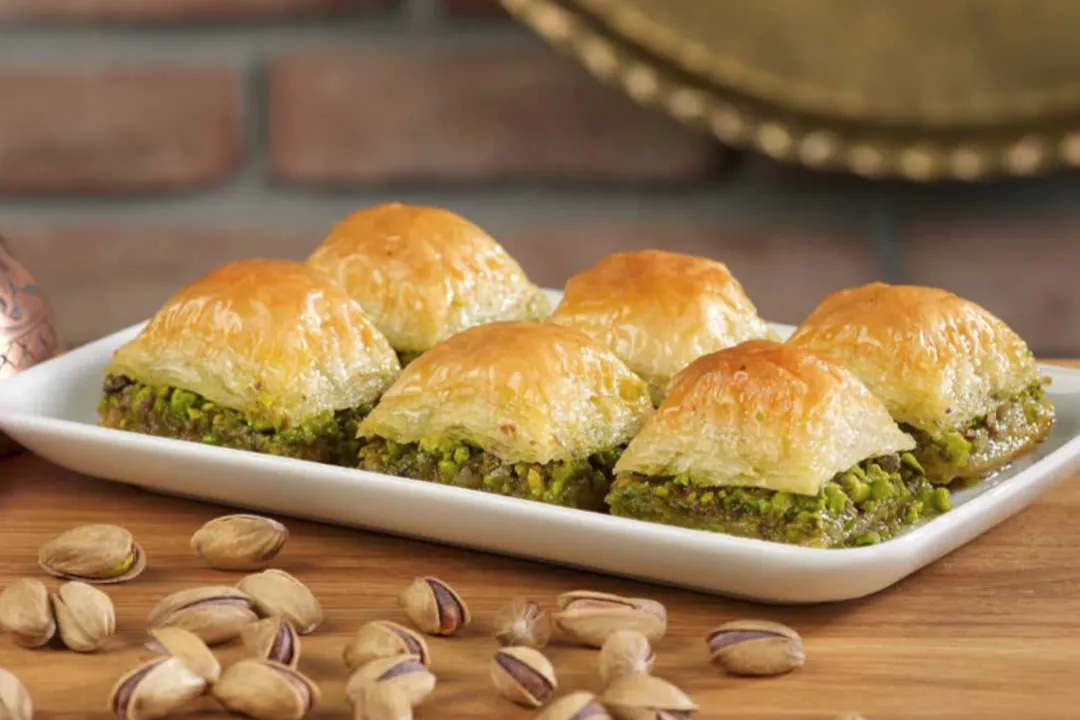Discover the storied flavors of Turkish cuisine, this marvelous blend of tradition and contemporary cookery.
Journey through a patchwork of flavors with roots in Central Asia. Mediterranean and Middle East. From regional dishes—Mantı and Hamsili Pilav to diet-conscious and hearty Pide—Turkish meal can be enjoyede in your home kitchen. Explore the importance of beverages, street foods, and confectioneries in Turkish culture while learning about a history that has animated this rich variety of dishes and drinks.
Clued in and hungry for even more? Let’s get started.

Regional Specialties and Hidden Gems
Discover the various regions of Turkey and their unique tastes. In Kayseri, try Mantı, a dumpling little bigger than a bead, stuffed with spicy meat, and paired with yogurt and garlic. In Cappadocia, revel in a Testi Kebab, cooked for hours in a covered clay pot, a dish full of history and tradition.
By the Black Sea indulge in Hamsili Pilav, rice steeped with fresh anchovies, tasting the sea and the trade of the fisher folk living where the land makes love with the sea. These bites tell the stories of their homes, a history tributary of food and heritage kaleidoscoping Turkish food into fine splendor.

Navigating Dietary Preferences: Vegan, Vegetarian, and Gluten-Free Options
Turkish cuisine is very adaptable and this is true even if you're vegan or gluten-free. Many of the traditional dishes are already plant-based or can be modified quite easily. Mercimek Köfte brand popular, made with red lentils, bulgur, and zesty spices, and is completely vegan. You will also find an abundance of meze dishes, like hummus and eggplant salads, that all vegans and vegetarians can enjoy too.

If you’re on a gluten-free diet, Turkish food is relatively easy to eat. Some meze, spreads, and soups can be enjoyed gluten free, like the popular lentil soup Ezogelin Çorba. Turkish cuisine revolves around fresh vegetables, legumes, and rice, producing an eclectic mix of dishes without the use of wheat. There are also gluten free versions of Turkish flatbreads and pastries, if you have a craving for some bread with your meal.

In short, there is plenty for everyone in this cuisine, but in order to enjoy it, the idea is to keep exploring and adapting these traditional recipes to fit your diet. Whether through a customization here or there in a classic recipe or learning an entirely new recipe customized for your diet, Turkish cooking is about enjoying flavors your way.
Home Cooking: Bringing Turkish Flavors to Your Kitchen
Picture the scent of fresh-baked Pide wafting through your home. You can make this scrumptious Turkish flatbread at home in no time. Top with whatever you have on hand, like cheese, eggs, or spicy sausage. First, stir up a soft dough, let it rise, and form an oval. Next, lay on toppings, bake until golden, and you have a delicious bread appropriate for any meal.
Next on the list is İmam Bayıldı, roasted eggplants stuffed with a fragrant mix of onions, tomatoes, and fresh herbs. It’s a vegetarian option that will please any diner and is both hearty and full flavored. The secret to its sumptuousness is cooking the vegetables down low and slow until they are completely soft and amalgamated with the olive oil. No amount of these slowly cooked vegetable can be anything less then tender and delicious.

And then, there’s Mercimek Çorbası, a zingy red lentil soup that’s one of the staples of Turkish cuisine. Made from red lentils, onions and carrots, and flavoured with cumin and paprika, it’s a warming, nourishing start to a meal. Whizz it up until it’s creamy, then serve with a dollop of chilli-flecked butter or a generous squeeze of lemon.

With these accessible recipes, you can get a true taste of Turkish cooking in your own living kitchen. Most of these recipes are easy enough for any cook to execute, and impressive enough to share with friends and family. Don’t hesitate to tweak them to suit your own tastes!
Turkish Beverages and Pairing Guide
In Turkey, beverages are a bright spot on the culinary experience. Kick start the morning with a bracing Turkish coffee it has a thick, rich savor that compliments a piece of Baklava magnificently because of its bold flavor. If you would rather sip something cooling, Ayran, a yogurt drink, can pair with a spicy meat kebab very well it’s tangy, chill flavor slicing through the spicy heat.

Another of the great social cornerstones of a Turkish meal, given in minute, tulip glasses, Turkish tea is the perfect partner of any course, or an easy pleasure to enjoy between them. Have a glass with some meze, for example, and the balance of a rich hummus or dolma dish will brighten alongside it. These are the common but diverse dancing partners of Turkish food enjoyed during any mealtime or during an afternoon snack that extend the sensory experience of every meal.
In-depth Examination of Historical Influences on Turkish Cuisine
Most fascinating about Turkish cuisine is that it is a tasty composite set. It’s as if you’re putting together a puzzle meal, but with ingredients pulled from a variety of spaces and times. Begin with the first layer, the timeless, nomadic Turks. They wandered with the land of Central Asia for two millennia. These nomads brought us yogurt and various kebabs—foods that could be easily transported and quickly cooked to serve a people always on the move. These influences continue to shape many prized Turkish dishes today.

Through subsequent centuries, the sun-drenched cuisine of the Mediterranean lands made their own mark. This land of olive oil, useful, flavorful vegetables, and as that was now a part of Turkey. This was a time of traveling trade routes, changes, new provisions, and new culinary techniques. These new tastes joined to complement and enhance those original recipes.
The role of Middle Eastern culture is similarly immense in Turkish cuisine. Spices like cumin, saffron, and the tart-edged berry, sumac, exploded upon Turkish plates, giving dishes their identifiable taste. The Ottomans, in their gallant way, found harmony in these flavors, constructing elaborate flavors that linger until our day. Through this wild, unruly parade of cultures, Turkish cuisine became a quilt of the strange and homey.

This odyssey of the plate, of territories and epochs, reveals what an intimate part food plays in the way of history and culture. Every morsel shared of Turkish food serves up a serving of history, a reflection of the many hands that once touched that recipe.
Exploring Turkish Desserts and Sweets
If you want something sweet that packs a punch, Turkish sweets hold the cure. Baklava is a towering dish of flaky pastry and nuts drizzled in syrup. It’s the iconic sweet for celebrations and family gatherings rooted in deep history. A more understated sweet is Turkish Delight, an aromatic and chewy reward that can be flavored in varieties.

This isn’t just dessert, it’s culture. Baklava’s history stretches hundreds of years. It is the embodiment of Turkish tradition and hospitality. For its part, Turkish Delight is as eastern in its presentation as a small cup of strong Turkish coffee gifted with it. Dessert says more than just sweet, even on the busy street.
For a lighter craving, sütlaç is a good start. This rice pudding, dotted with cinnamon, pepper the steady stream of street food on offer, creamy and traditional. For something heavier, there’s künefe, a buttery, cheesy dessert prepared in a giant paella pan and sweetened with a syrup of sugar and lemon juice—a dense, rich option for those with a hedonistic sweet tooth, unboundary. Turkish desserts run the full spectrum of tastes and customization anywhere.
Exploring the Street Food Scene in Turkey
Explore the vibrant world of Turkish street food, where on every corner you can catch a bite of something wonderful. Imagine picking off pieces of a warm, fresh baked Simit. A sesame-covered bread ring, it is often found in the morning tea. If you prefer savory treats, Lahmacun is a street food essential.
Often referred to as Turkish pizza, lahmacun is a thin, crispy sheet of bread topped with spicy ground meat and veggies. It is then sprinkled with parsley and doused with a spritz of lemon. Excellent for handheld eating on the run, the lahmacun is nothing to be shy about.

Of course, Turkish street vendors also cook up Gözleme, a wonderful flatbread wrap stuffed with, well, just about anything. Cooked on a griddle, stuffings can range from simple potato or savory cheeses and spinach—perhaps the quintessential Turkish street food indulgence you will find everywhere during your travels.
Conclusion: Embracing the Richness of Turkish Cooking
Spinning the atlas of Turkish cuisine is a vibrantly bound adventure story of histories and tastes.
From streetside chaos of Simit flavored air to nourishing bowls of home kitchen alchemy, every bite comes with a story. For those who revel in the past or sit in the moment, Turkish cuisine has universes of taste to give.
Although, keep in mind that Turkish food is more than its taste. It’s a language of lineage and heart, so listen to that language and taste it. Dive in, cook, eat, and be enriched, lezzetli and doyumsuz.
